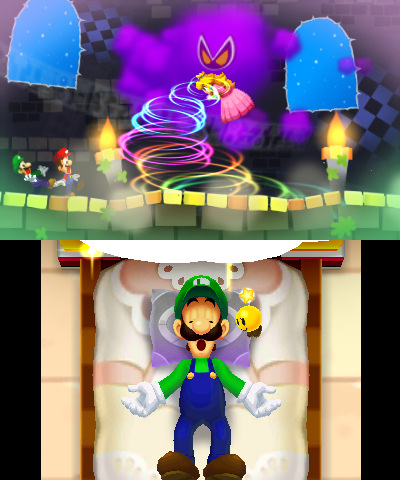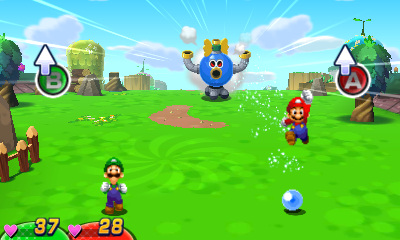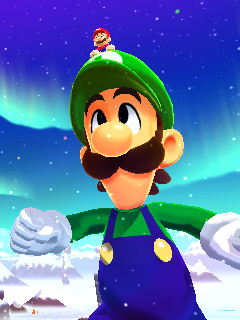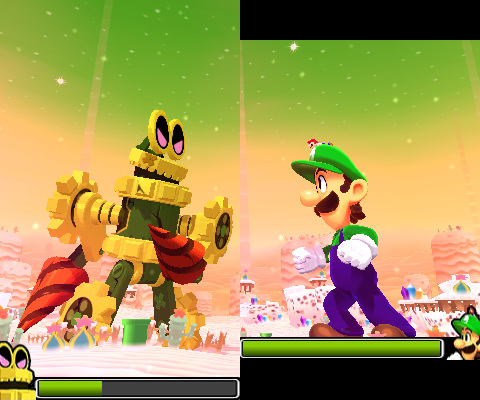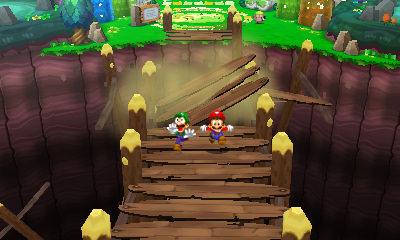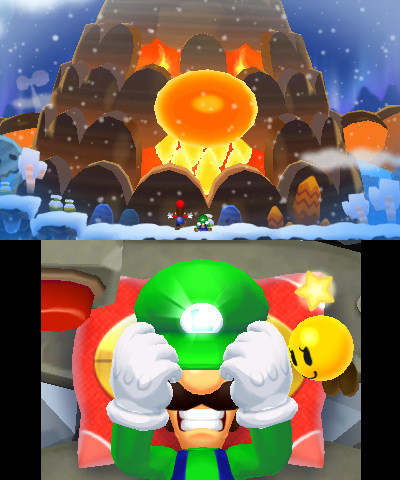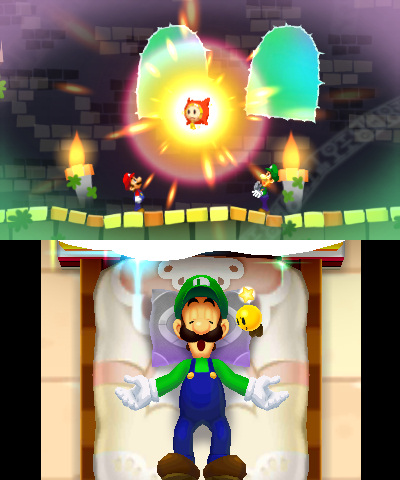I wanted to play Mario & Luigi: Dream Team, the fourth and latest entry in the action role-playing game series from developer AlphaDream, because I’m a fan of Paper Mario’s similar style and because Nintendo christened 2013 the Year of Luigi. For a character whose fictional peers and players alike constantly ignore and belittle him, that’s a big deal.
While the recent New Super Luigi U looks to me like a character-swapped version of New Super Mario Bros. U, Dream Team (out Aug. 11 for Nintendo 3DS) promises the younger mustachioed brother redemption. In his dreams, Luigi can be anyone — as brave and strong as his big bro. I wondered if the developer would take this opportunity to honor him seriously, and a few minutes in, I was immediately skeptical as he tripped over his own feet and others lobbed their usual ridicule. Before long, however, the game’s themes took precedence, and Luigi conjured a world where he finally belonged.
What you’ll like
Welcome to Pi’illo Island
In this adventure, Mario, Luigi, Princess Peach, and their pals set out for a faraway island after receiving a mysterious invitation. The inhabitants of Pi’illo Island waste no time receiving them with warmth and breaking into celebration, but omens have clouded our heroes’ journey from the outset. A demonic bat king named Antasma soon escapes from the dream world, where the legendary Pi’illo folk (yep, they look just like pillows!) and their Prince Dreambert have imprisoned him. The villain teams up with Bowser for double the evil.
From the moment it begins, Dream Team is a wonderland of 3D graphics, color, and sound. Nothing’s better than seeing a monster erupt into a shower of rainbow stars or watching countless Luigis spin around the screen. The dream world that Luigi can access through sleep (only he wields this power) is a remixed version of reality, from the slowed-down music to the multilayered backdrops. Just when you thought Pi’illo Island was beautiful — with textured, clay-like graphics you can almost reach out and touch — the game takes its style to the next level.
Even an act as simple as breaking purple nightmare chunks, which have crystallized the lost Pi’illo people (your allies), is satisfying to the ears and eyes. Hear it crunch as it shatters in 3D. I especially love the charming Italian, Popeye-like gibberish that the brothers speak.
Battles big and small
What’s amazing about the Mario & Luigi formula is that it’s a turn-based role-playing game with an active system. Players can never sit idly back and mash buttons to speed through menus and attacks like in other titles.
The addition of 3D is a huge boon. Every battle becomes a test of observation, timing, and skill. Enemies cycle through a number of different offensive moves and can charge from all sides, making matches as three-dimensional as they look. Because each adversary exhibits tells, or signs of how to learn its behavior, Dream Team is all about mastering this dynamic and clearing expert challenges (dodging or countering without taking damage) for rewards.
Fighting is key to long-term victory, so players should engage every creature they see on the field. With preemptive strikes and deflective maneuvers, these encounters can be quick and highly enjoyable once you get the rhythm down.
Mario & Luigi can pull off Bros. Attacks (which sometimes involve tilt functionality) when they’re working together, but in the dream world, Luigi’s essence fuses with Mario. The result is ridiculously gratifying. Stomp on an army of enemies and a dozen Luigis (clones called Luiginoids) rain down, too. Special moves called Luiginary Attacks enable Mario to roll up a hundred Luiginoids in a ball to bowl over foes or a hammer to smash them flat.
The game is very fair, but it pumps up the difficulty during boss fights, which use every available benefit to the 3DS to great success. The best part is when Luigi focuses his energy and grows to an enormous size in giant showdowns. In these unique events, where players turn the 3DS sideways and use the stylus to trigger a whole new set of moves and counters, the green-suited plumber is tough enough to shake mountains.
Anything’s possible
Through Luiginary Works, the dream world offers Mario and Luigi ways to interact with their environment that are otherwise impossible. This is the reason why players will tug at the taller plumber’s mustache or nose on the bottom touch screen, but the component is so much more than goofy face manipulation.
Luigi can merge with certain background objects to help Mario navigate through dreams. Many of these are simple, like a palm tree that can stretch its branches down to Mario, grab him, and fling him upward. A fan can blow platforms, coin boxes, and more into the foreground. Some Luiginary Works are cooler, like a propeller that lets Mario stick to and climb along walls or a whirlpool that changes the directional pull underwater. But the best and most versatile is the constellation. It lets Luiginoids build into stacks with Mario riding on top, and later on, players can toy with other shapes as well.
Each form has multiple applications, too. For example, the tower of Luiginoids can lean to hit switches, ground pound to smash blocks, or jump great heights into the air. It can even compress to pass through areas where the ceiling is low and flick away enemies on the screen as if they were gnats.
Small conveniences
We often take for granted the little details that make games so functional and inviting, which is what allows us to become totally immersed in them as the hours tick by like seconds. Mario & Luigi: Dream Team is one of those wonderful few, and the most insignificant of features make progressing tremendously easier.
The bottom screen can switch to a map on which players can zoom or drag to view the full scope. Saving is available anytime and anywhere. And if you lose in combat, the game lets you restart from the beginning or bump down to an easier mode. It never reverts to the Start screen unless you quit.
Plus, when Mario or Luigi levels up, players can spin a number roulette to pump extra points into whatever stat they choose. Hitting milestones unlocks rank bonuses, like permanent reduced damage or an extra gear slot. These small but considerate elements add up in a big way.
Luigi’s world
Mario & Luigi: Dream Team contains different moments when, without beating the audience over the head with pity or sympathy or even psychoanalysis, we understand how it must feel to be Luigi. He’s routinely clumsy in the real world but talented and essential in the dream realm. In the deepest reaches of his subconscious and the minutes before a giant battle begins, we can learn his innermost thoughts — actually read them on the screen. We witness the expression of fear or doubt on his face before he shakes it off and unleashes a mighty blow. This is Luigi like we’ve never seen him before, and developer AlphaDream sets the stage and then allows us to interpret his true character for ourselves.
These qualities give new meaning to the times when he stands by and lets Mario take the credit for saving the day. He’s not a proud or self-absorbed hero. He’s all the better for it. This is very much his year.
What you won’t like
Giant investment
The giant battles are one of the highlights of Dream Team, but they’re not perfect, and the problems with them are inconsistent. In other words, they’re super fun but occasionally a pain in the overalls.
Because these scenarios depend on the stylus, they require various swipes, taps, and other motions, like drawing circles. These give the 3DS touch screen a real pounding; it’s going to take some heavy abuse during these scenes. Usually, actions execute as planned, but sometimes they can give you grief. Figuring out how fast or hard to use the stylus can be trying. Maybe I’m just that uncoordinated, but I found the repetitive swipe motions — like to push back an opponent — the most difficult to master. These battles are no small undertakings, either. They demand a lot of time, concentration, and endurance, and they only get harder.
During one, the 3DS’s gyroscope actually quit on me. I was worried I broke it because I was playing so rough, but I restarted the system, and it worked fine. However, it’s definitely frustrating to lose after dumping so much time into these much longer, slower confrontations.
Pacing problems
I never got bored with the locations Dream Team took me to or the activities it engaged me in — except in a few instances. One area in the middle of the game is a little too extensive, and another involves a fetch quest that feels embarrassingly out of place.
The worst is the end, which introduces — guess what — a looming evil castle that players will immediately recognize as the final battleground — maybe five, 10 hours away. That’s not the case. The story drags on and forces you to visit new areas in old corners of Pi’illo Island, run around collecting parts and finding someone to assemble them, and reach goals countless roundabout ways. Then, when you’re finally able to infiltrate the castle, it lays down boss after boss. The whole last chapter gets out of hand.
I’m all for extra content, and Dream Team includes minigames and sidequests galore (completing picture puzzles, flexing skills for prizes, freeing Pi’illos, and so on). This easily extends to 50 hours or more, but it stretches paper-thin. And don’t even get me started on the final boss, who spams a move that can make it near impossible to beat him (unless you put the battle on easy mode) and is a huge load on your time.
Conclusion
Mario & Luigi: Dream Team is a must-have for the Nintendo 3DS. It’s loveable, endearing, and a good, healthy challenge — until you hit 35 hours or so, when the developers start cramming in superfluous content and increasing the number and intensity of giant battles. It’s a shame that one of the best features almost becomes a detriment through overuse.
Regardless, these issues feel like small prices to pay for the enjoyment you’ll get out of Dream Team, where worlds and characters burst with personality and imagination and Luigi finally gets his dues. This may be one of the most memorable handheld titles you’ll play this year. And what a special year it is.
Score: 90/100
Mario & Luigi: Dream Team was released for the Nintendo 3DS on August 11, 2013. The publisher provided GamesBeat with a download code of the game for the purpose of this review.
VentureBeat's mission is to be a digital town square for technical decision-makers to gain knowledge about transformative enterprise technology and transact. Learn More

